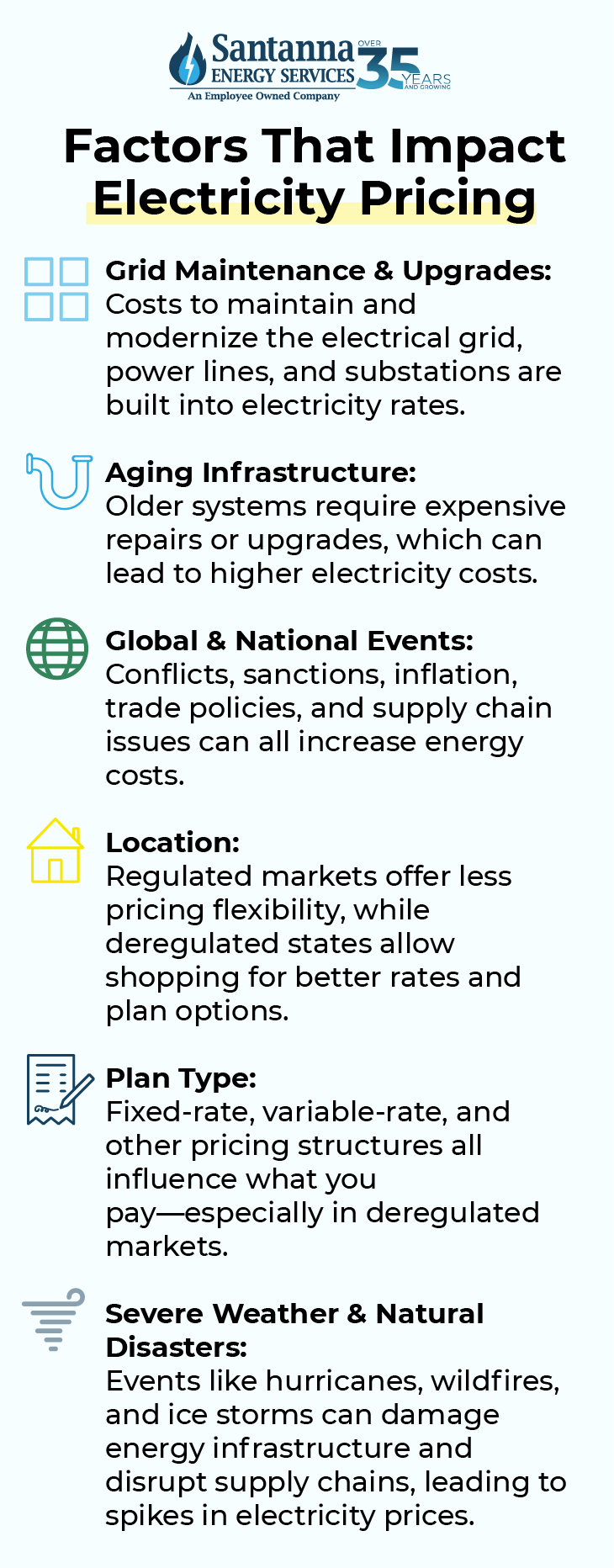Should You Switch Your Electricity Plan During the Summer or Winter?
by Tyler Castle
15.8 min read

Energy costs fluctuate throughout the year, influenced by seasonal demand, fuel availability, and regional grid conditions. For consumers looking to maximize savings, a key question arises: Is it better to switch energy plans during the summer or winter?
Electricity rates often spike during extreme weather seasons—summer sees higher demand due to air conditioning, while winter heating needs can also drive up prices if you use electricity as your primary heating source. But timing your switch strategically can help you lock in a lower rate, avoid seasonal price hikes, and even benefit from supplier incentives.
This guide will walk you through the factors that affect electricity pricing, the best times of year to lock in a new rate, and how to choose the right plan for your home. Let’s get started!
Are Electric Rates Higher in Summer or Winter?
Electricity rates typically peak during the summer months. This surge is primarily due to increased demand for air conditioning, which places additional strain on the electrical grid.
Electricity prices tend to peak during the summer due to increased demand, as utilities rely on costlier energy sources to accommodate the increased consumption. As demand rises, utilities often resort to activating higher-cost generation sources to meet consumption needs, leading to elevated prices.
Reasons Electricity Rates are Higher in the Summer vs. Winter
Electricity rates tend to surge in the summer due to a combination of increased demand, infrastructure strain, and market-driven fuel cost fluctuations. Here’s why summer electricity costs are generally higher than in winter:
1. Increased Cooling Demand
According to the EPA, 89% of U.S. homes use some type of air conditioning to cool of their homes and 67% of these homes have central air conditioning installed. This widespread use of air conditioning during hot months leads to a sharp rise in electricity consumption leading to higher electricity rates to keep up with demand.
Peak hours in summer—especially in the late afternoon and early evening—experience intensified energy usage, further driving up rates.
2. Strain on Infrastructure
When there is more demand for electricity, the electric grid often gets strained and overloaded. Overloaded transformers and power lines struggle to handle higher loads, leading to inefficiencies and even blackouts.
Utilities often invest heavily in grid maintenance and emergency response measures during summer, to ensure the energy grid can handle demand and these costs get passed down to customers. In extreme cases, elevated summer demand can overload power grids, leading to congestion and requiring utilities to activate additional power plants. When this is the case, this extra cost to keep up with demand is supplimented in raised electricity rates in the summer.
Heat waves can also cause equipment failures, transmission line inefficiencies, and power outages, increasing maintenance and operational expenses for utility companies. This can lead to higher electricity rates in the summer to keep the grid functioning.
3. Fuel Price Volatility
The cost of fuels used for electricity generation, such as natural gas, coal, and oil, tends to rise during the summer due to increased consumption and global supply constraints.
During summer, demand for electricity skyrockets as millions of homes and businesses crank up their air conditioners. To keep up, power plants burn more fuel to generate enough electricity, leading to higher fuel consumption and rising prices.
Natural gas plays a major role in electricity generation, especially in the U.S., where it powers nearly 40% of the grid. When temperatures rise, power plants increase their reliance on natural gas-fired generators, which pushes prices up. Additionally, the need for importing additional energy sources in certain regions can drive up costs even more.
4. Increased Use of Renewable Energy Can Impact Pricing
While renewables like solar and wind help stabilize electricity prices, solar production peaks during midday but drops in the evening—right when energy demand is at its highest. This is called a duck curve, which refers to the pattern of electricity demand compared to solar energy availability throughout the day. During daylight hours, solar energy production surges, reducing the need for other power sources. However, as the sun sets and solar generation declines, electricity demand rises sharply in the evening, creating a steep increase in grid reliance—hence the curve’s resemblance to a duck’s shape.
To compensate for this gap, utilities may turn to more expensive, fossil-fuel-based generation in the late afternoon and evening, further increasing costs.
5. Regulatory and Market Dynamics
Another factor that contributes to higher electricity costs in the summer are changes in market dynamics. Many utility companies adjust rates seasonally, anticipating higher summer demand. This can include higher base rates or dynamic pricing models that charge more during peak hours. In doing so, electricity prices tend to rise.
In the same way, states with deregulated energy markets may experience even greater price fluctuations, depending on market conditions and supplier competition.
6. Increased Residential Electricity Use Due to Summer Break
One often-overlooked reason why electricity rates are higher in the summer—especially for residential customers—is the impact of summer break. When schools let out, kids and families spend more time at home, leading to a surge in electricity usage.
With children home all day, air conditioning, TVs, gaming consoles, tablets, and other electronics run for longer hours than they do during the school year. More daylight also means more time spent indoors with cooling systems running, as well as increased use of outdoor appliances like pool pumps, patio fans, and electric grills driving the strain on the grid up as well as electricity rates.
7. Reduced Energy Efficiency in Homes
Many homes experience reduced energy efficiency in the summer, leading to higher energy consumption per household and higher energy bills. Poor insulation allows cool air to escape, making AC units work harder and increased use of ceiling fans, pool pumps, refrigerators, and dehumidifiers adds even more demand for electricity.
When Is the Best Time to Lock in Your Electricity Rate?
Timing is everything when it comes to locking in a favorable electricity rate. If you sign up for a new energy plan at the wrong time, you could end up paying significantly more than necessary.
The optimal periods to secure favorable electricity rates are during the spring and fall, known as “shoulder seasons.” During these times, mild temperatures lead to reduced demand for heating and cooling, often resulting in lower electricity prices.
Since people aren’t running air conditioners or heaters as frequently, energy suppliers typically lower their rates to attract new customers. This makes spring and fall the ideal times to secure a stable electricity rate on a plan that doesn’t shift your rate for the duration of your contract before prices rise again.
Why You Should Switch Electricity Plan in the Spring and Fall
Switching your electricity plan during the shoulder seasons comes with numerous benefits. Let’s take a look at some of the most valuable:
1. Energy Rates Are Typically Lower
Electricity prices tend to drop in spring and fall when demand is lower. With milder temperatures reducing energy usage, suppliers tend to adjust their rates accordingly. Locking in a plan during these seasons could help you secure a lower rate before peak seasons drive prices up.
2. More Competitive Plan Options
Energy providers sometimes introduce their best deals during off-peak times to attract new customers. With fewer people shopping for plans, there’s less competition, giving you more leverage to find a deal that fits your budget and energy needs. During this time, suppliers might test out new promotions and pricing models to get customers. So, you might get lucky with an exclusive plan!
3. You Avoid Peak Season Price Spikes
By switching in the spring or fall, you can avoid locking in a high rate during peak summer or winter months. If you wait until energy prices rise with extreme temperatures, you may end up paying more for the same plan that would have been cheaper earlier in the year.
4. More Predictable Market Conditions
Energy prices can fluctuate significantly based on weather patterns and market demand. Spring and fall tend to have more stable pricing trends, making it easier to lock in a long-term, budget-friendly plan without worrying about sudden price spikes.
5. Time to Evaluate Plan Benefits
Switching in a low-demand season gives you the opportunity to carefully review plan details, contract terms, and available incentives. You can compare options without the pressure of rising costs or expiring contracts forcing a rushed decision. This is a great opportunity to evaluate your energy provider as well and determine if you’d like to switch to a more competitive retail energy supplier.

Factors That Impact Electricity Pricing
Keep in mind that even when you lock in an electricity plan during seasons of low demand, there are a few factors that can still affect the electricity price for your plan.
First off, the price of natural gas, coal, and oil plays a major role in determining electricity rates. Since power plants rely on these fuels for generation, fluctuations in fuel costs directly impact electricity prices. When fuel prices rise—due to supply chain disruptions, geopolitical events, or natural disasters—electricity rates increase accordingly. These types of events can happen anytime.
Maintaining and upgrading the electrical grid, power lines, and substations is essential to ensuring reliable energy distribution. These costs are factored into electricity rates which can increase or decrease at any time throughout the year.
Many parts of the U.S. have older infrastructure that requires costly repairs and upgrades. So, when these systems are upgraded, electricity rates can rise as well. Upgrading grids to support solar, wind, and battery storage requires investment, which can lead to higher rates.
Electricity prices are not just determined by local factors—global and national events can also have a major impact on these rates too. Events like conflicts in oil-rich regions or sanctions on major fuel suppliers can disrupt global energy markets, causing fuel prices to spike. Inflation, trade policies, and supply chain issues can affect electricity costs by increasing operational expenses for utilities which can happen at any time during the year.
Where you live plays a huge role in how much you pay for electricity. In some states, utilities control electricity pricing, and consumers have no choice but to pay the set rate. Prices are often stable but lack competition. In states with energy choice, consumers can shop for different providers, which can lead to more competitive pricing, customized energy plans, and better deals.
Lastly, the type of electricity plan you choose directly impacts how much you pay. If you live in a deregulated energy market, you have the choice to choose from a variety of energy plans where pricing structures and rates can vary. Because of this, the plan you choose can affect how much you pay for electricity regardless of when you sign up.
What It Means to “Lock In” Electricity Rates
Locking in an electricity rate means signing a contract with an energy provider to secure a fixed rate per kilowatt-hour (kWh) for a set period, typically ranging from 3 to 36 months. This agreement shields consumers from market fluctuations that cause electricity prices to rise due to seasonal demand, fuel cost changes, or supply constraints.
“Locking in” your rate typically refers to a fixed-rate energy plan. When you lock in a fixed rate, your electricity price remains the same throughout your contract term, regardless of market volatility. Keep in mind that you typically “lock in” the energy supply portion of your bill, while delivery and utility fees may still vary depending on your location.
Locking in an electricity rate is a smart strategy for budget-conscious consumers who want price stability and protection from market unpredictability.
The Benefits of Locking in Your Electricity Rate
Securing a fixed electricity rate offers peace of mind and long-term financial benefits. One of the biggest advantages is protection against rate increases—since energy prices often fluctuate due to changes in fuel costs, extreme weather, or regulatory shifts, locking in a rate shields you from sudden spikes.
A fixed rate also brings predictability to your monthly bills, helping you avoid the impact of seasonal surges in demand during hot summers or cold winters. Over time, this stability can potentially translate into long-term savings, especially if market rates rise and you’re still paying the lower, locked-in amount.
Explore Santanna’s Plan Choices
At Santanna Energy, we believe in giving you control over your energy costs with flexible, straightforward plans designed to fit your lifestyle. Whether you prefer stability with a fixed rate, unlimited energy for predictable budgeting, or eco-friendly options to reduce your carbon footprint, we have the right plan for you.
Fixed-Rate Energy
If you want to avoid unexpected rate hikes and seasonal price fluctuations, a Fixed-Rate Energy Plan is the perfect solution. By locking in your rate for the entire term of your contract, you’ll enjoy a consistent rate every month—no matter how market prices shift. This plan is ideal for anyone who wants peace of mind when budgeting and protection from rising electricity rates. Homeowners and renters alike can benefit from the financial stability and security that a fixed-rate plan provides.
Unlimited Energy
For those who want total simplicity, our Unlimited Energy Plan allows you to pay one set supply charge every month, regardless of how much electricity you use.* No more worrying about spikes in energy consumption—just one easy, predictable supply charge. This plan is perfect for households that want straightforward budgeting and anyone looking for a hassle-free energy experience.
Earth-Friendly Electricity
Sustainability has never been easier. With our Earth-Friendly Electricity Plan, Santanna matches 100% of your electricity usage with Renewable Energy Credits (RECs) sourced from wind, solar, and hydropower. This means you can support renewable energy and help reduce carbon emissions without making any changes to your daily routine. If you’re passionate about sustainability and want an effortless way to support cleaner energy, this plan makes it simple to reduce your environmental footprint while keeping your home powered.
How to Find the Best Energy Supplier and Plan
Selecting the right electricity supplier is essential to ensuring you get the best value for your energy needs. With multiple providers available, here’s how you can effectively compare options and find the best fit:
- Assess Your Energy Consumption: Review your past electricity bills to understand your typical usage. This helps determine the most suitable plan and ensures you select a rate that aligns with your needs.
- Align with Your Energy Preferences: Consider your priorities—whether you’re looking for the lowest rates, want to add predictability to your bill, or want to support renewable energy sources.
- Research Providers Thoroughly: Most energy suppliers provide detailed information about their pricing, contract terms, and services on their websites, making it easier to compare options.
- Compare Plan Types: Electricity providers offer a range of plans, including fixed-rate, unlimited, and renewable energy plans. Evaluate each option based on your consumption habits and financial goals.
- Review Customer Feedback: Checking customer ratings and reviews can give you insights into a supplier’s reliability and customer service responsiveness.
- Look for Rewards and Bonuses: At Santanna, we give exciting monthly rewards and referral bonuses to help you get more value out of your plan.
How to Lower Your Summer Electric Bill
Managing electricity consumption during the hotter months can significantly lower your energy bills while keeping your home comfortable. Here’s how:
- Schedule Routine HVAC Maintenance for Optimal Efficiency: Your air conditioning system works hardest during summer, making regular maintenance essential. Cleaning filters, checking refrigerant levels, and inspecting ducts can prevent inefficiencies that drive up energy costs.
- Seal Air Leaks to Prevent Energy Waste: Small gaps around windows, doors, and vents allow cool air to escape and hot air to enter, forcing your AC to work harder. Sealing leaks with caulk, weather stripping, or spray foam insulation can reduce energy loss and improve indoor comfort.
- Improve Home Insulation for Long-Term Savings: Proper insulation reduces heat transfer, keeping your home cooler in the summer and warmer in the winter. Adding insulation to walls, attics, and crawl spaces helps stabilize indoor temperatures, lowering air conditioning usage.
- Upgrade to Energy-Efficient Appliances: Energy Star-rated appliances use less electricity while delivering the same performance as traditional models. Upgrading to energy-efficient refrigerators, air conditioners, and washing machines can cut energy costs significantly over time.
- Turn Off and Unplug Electronics When Not in Use: Many devices continue to draw power even when turned off, a phenomenon known as phantom energy drain. Unplugging chargers, TVs, and gaming consoles or using smart power strips can reduce unnecessary electricity consumption.
- Maximize Natural Ventilation with Open Windows and Doors: Take advantage of cooler morning and evening air by opening windows and creating a cross-breeze in your home. This natural airflow reduces the need for air conditioning, especially at night.
- Use Curtains, Blinds, and Outdoor Shading to Block Heat: Direct sunlight through windows can quickly raise indoor temperatures. Use blackout curtains, reflective blinds, or outdoor awnings to minimize heat gain and keep your home cooler naturally.
- Choose an Unlimited Energy Plan: With an Unlimited Energy plan, you can avoid unexpected price hikes in the supply charge portion of your bill when your electricity usage increases in the summer. Your supply charge stays the same from the moment you sign up, providing peace of mind throughout the length of your contract.*
FAQs
Are there fees for switching providers?
While many providers do not charge a fee to switch, some do, and some may impose early termination fees if you leave your contract before its end date. These fees can vary widely, so it’s crucial to review your current contract terms before making a switch.
Will my power supply be interrupted during the switch?
No, your power supply will not be interrupted when you switch providers. The transition is seamless, with your utility company continuing to deliver electricity without any service disruption.
How long does the switching process take?
The switching process typically takes a couple of weeks, but it can be longer in some cases. The exact duration depends on your location and the providers involved.
Switching energy plans at the right time can save you money, provide pricing stability, and align with your energy needs. Whether you choose to lock in a fixed rate, take advantage of Unlimited plans, or explore renewable energy options, understanding seasonal rate fluctuations, contract types, and supplier differences empowers you to make the best decision for your home or business.
At Santanna Energy Services, we make it easy to find the perfect energy plan tailored to your lifestyle. Whether you’re looking for price protection with a fixed-rate plan, unlimited usage for one simple monthly fee, or an earth-friendly plan that supports renewable energy, we have options that fit your needs.
Now is the time to take control of your energy costs! Explore our plans and switch to Santanna today.
* Restrictions apply. Enrollment based upon program eligibility. Customers using more than 125% of normal monthly usage as determined by Santanna may be required to switch plans.
Tyler is an experienced energy professional, having worked for Santanna Energy Services, for the past four years. He is passionate about renewable energy and believes that diversifying the energy grid is the key to a sustainable future. Tyler is dedicated to supplying consumers with the best possible energy solutions and works diligently to make sure that Santanna can deliver the highest quality service.







